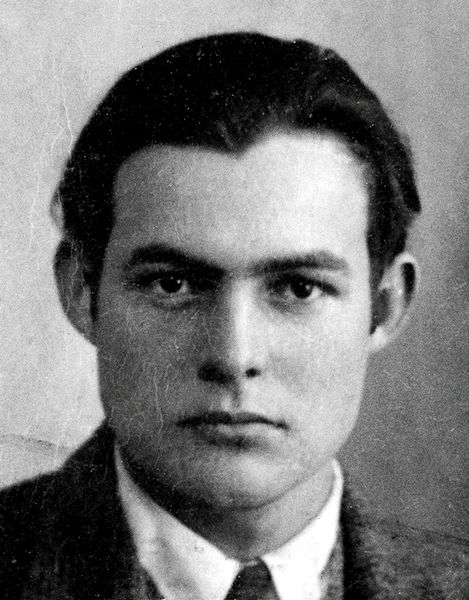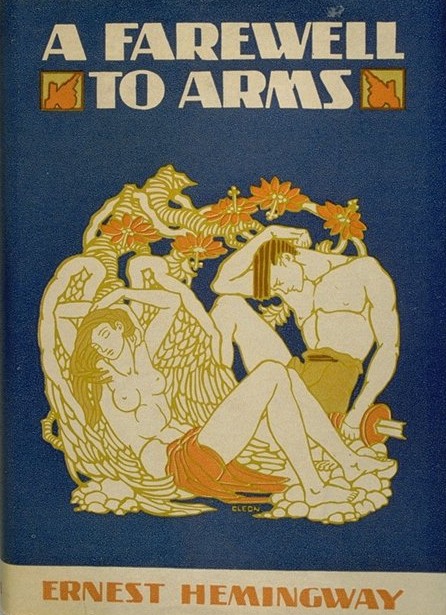
According to The New York Times “A new edition of A Farewell to Arms, which was originally published in 1929, will be released next week, including all the alternate endings, along with early drafts of other passages in the book.” The new edition will be released by Scribner, now a Simon & Schuster imprint. The edition is a collaboration between Scribner and Hemingway’s estate and will include the original and alternate endings.
It is not surprising to me Hemingway rewrote the ending thirty-nine times or what some say was over forty. Having visited Hemingway’s Key West home February of this year, a birthday present, I saw firsthand evidence of the writer’s dogmatic work rituals. He had a thin walkway built from the second level of his house to the second level of the carriage house, where Pauline — his first, second, third, oh hell, I’ve lost count — wives, renovated the top room into a writing studio for him. I must make a side note here: Pauline also replaced all the ceiling fans with fancy chandeliers. I, for one, would have left her for that bit of fanciness. The Keys are far too hot in the summer for chandeliers in lieu of fans, which I experienced touring his home, sweat dripping, resulting in a particular distaste for the woman, though, I’ve never spoken a word to her. I will say, in her defense, my affections kindled when I learned how saucy she was. Hemingway/Pauline lore has it that Hemingway carried home a urinal one day — a memento of the evicted Sloppy Joe’s (the real Sloppy Joe’s) — and Pauline forbid the urinal in the house. Apparently, Hemingway plopped it on the back lawn in a manly way and said it was to stay put, so Pauline had it enshrined as a mosaic. It’s really quite lovely now. The cats still drink from it or rather from the fall of water above it. I’d drink from it, too, if I were a cat.
Hemingway’s walkway is/was a rickety thing, akin to a rope bridge, and high enough many a writer would be fearful to walk it. Apparently Hemingway woke early each morning and walked the bridge to his studio before speaking with anyone, until he knocked off in the afternoon for some fishing on the Pilar then drinking at Sloppy Joe’s, which was not the tourist trap/club scene it is today. The real Sloppy Joe’s is quieter, around the corner, a place where a person can have a beer and play pool for hours, a one-man show with guitar playing in the background. I found Hemingway’s style, or what I could make of it, comforting in a daily routine kind of way. He wasn’t so different than my Pappy, who fished on the Ohio River any chance he could and often took me with him. According to my Mammy, I was the only grandchild who could sit still in the tiny bass boat. Pappy and Hemingway would have likely gotten along fine except for the drinking and fighting. Pappy was a church man. Or at least he was when I knew him. Some family stories say different. Everyone should have stories like that, I think.
Another side note, as I couldn’t fit it gracefully elsewhere, is an odd bit of information that will likely stay with you as it has with me. Hemingway’s bathroom was in the front of the house. The toilet, in particular, directly in front of the window facing the walkway below. As the tour guide tells it, Hemingway would sit on his throne and yell through the window to passersby and visitors as he completed his business with the toilet. This strikes me as particularly enchanting. I never realized, until the tour guide recited this story, how literary my father was. I have apparently grown up in a very literary household.
As colorful and entertaining as Hemingway lore is, one finds it easy to have a love-hate relationship with Hemingway and his words. His female characters aren’t what one would consider fully realized and his prose is perhaps at times too simplistic, which may have been an effect of Maxwell Perkins, except that Perkins edited Fitzgerald, too, and I wouldn’t count Fitzgerald on the same level of minimalism. Then there’s the whole un-evolved male factor. But still, Hemingway has undoubtedly left behind works to be read. They should be read. By many ages. The Old Man and the Sea was the first “grown up book” my son read at the ripe age of eleven. It’s still one of his favorite stories. Mine too, though, trumped by The Sun Also Rises and “Hills Like White Elephants.”
I sometimes ask myself what it is about Hemingway that keeps me enthralled. Because I most certainly am. Enthralled. And a little in love with his passport picture. Maybe it is pure irony. The unapologetic maleness of him. He made no qualms about being an ass. His male characters are asses, usually, a notable exception being Santiago, but still, they are often and fully asinine. Still, Hemingway wrote truthfully and unabashedly from a male point of view. He didn’t mask it for the sake of politeness and as infuriating as that perspective might be at times, there is value in it. It is a record. An era. A mindset as timeless as Shakespeare’s Bottom. All in all, I’m not sure if Hemingway’s work would have been so poignant if he weren’t an ass. I suppose I wouldn’t want to read a story from “nice.” I prefer my characters brooding and flawed. Yes, Hemingway was an ass. And it’s one of the reasons I love his work so. All writers should dabble in being asses. And in the spirit of the moment, I’m going to be an ass now. I’m going to give you the ending to A Farewell to Arms, which may disappoint those of you who haven’t read the novel, so go ahead, turn away. Or better yet, pick up the novel and read it. Read the original. Read the new edition. Read it because to pick up a book well-voiced and rigorous is far better a thing than any.
And here are the last words of Papa’s Arms…
“But after I had got them out and shut the door and turned off the light it wasn’t any good. It was like saying good-by to a statue. After a while I went out and left the hospital and walked back to the hotel in the rain.”
Goodbye, Papa. And happy late birthday. We miss you.
Ernest Hemingway, A Farewell to Arms, Scribner Book Company. New York, NY. 1929.
The Ernest Hemingway Collection is located at the John F. Kennedy Presidential Library and Museum in Boston.
Hemingway Home in Key West, FL
Original Location and Vibe of Hemingway’s Sloppy Joe’s: Captain Tony’s
A Lot of Fun but Tourist Trap Club Scene: Sloppy Joe’s



